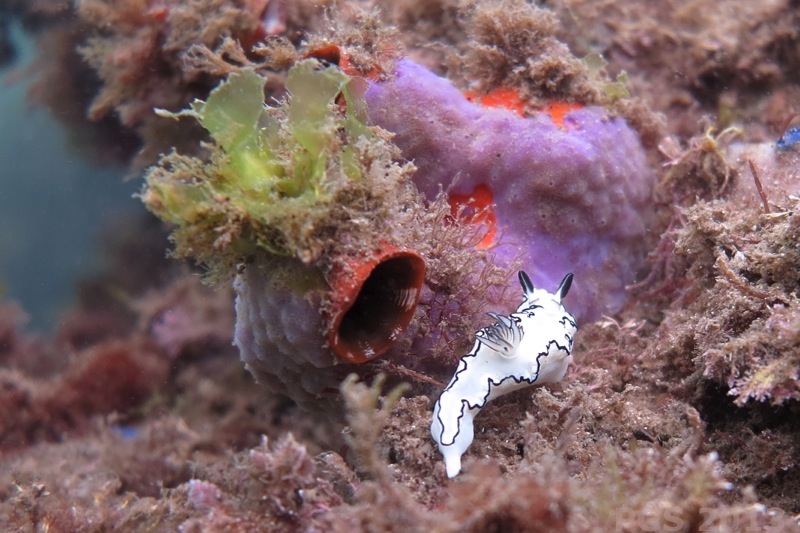38. Prismatic
When I was in Sydney earlier this month, the waters were full of nudibranchs, tiny molluscs making their way up and down the rocks and reefs. When I say “full,” I mean that there were more than usual – you might see six or eight on a swim, looking closely. These are still fairly new animals for me, and I’m amazed nearly every time I see them. Above is Doriprismatica atromarginata. All the shots in the post (except for the last) were taken following this individual. He (and she) climbed slowly past an ascidian tunicate – one of the trumpet-like filter-feeders, quite closely related to you and me, that I wrote about a few posts back. The tunicate is covered by an encrusting sponge, a layer of purple over its body. The tunicate itself, I think, is orange.
India Morrison, occasional commentator on this site, said of this scene that it looks like the tunicate has “turned its head to gape.”
With their pure white, the simplicity of their colors, the prismatic nudibranchs look more like something from physics than biology, an intrusion from a different plane. Their white is that of artists’ paints with metallic names: titanium white, zinc white. As they’re so delicate, they also look like intrusions of another kind – like angels or fairies. In late 19th and early 20th century England, fairies for a time became a topic of intense interest, with much-discussed sightings. The most famous case was the Cottingley Fairies, “captured” by two girls, Elsie Wright and Frances Griffiths, in a series of photographs taken in 1917 and 1920. Many people were convinced the photos were genuine, including, most notably, Sir Arthur Conan Doyle, author of the Sherlock Holmes stories.
Sherlock Holmes! The stakes were surely high for Conan Doyle, and he steadily advocated the photos’ authenticity. Eventually, many years after Conan Doyle’s death, the girls admitted they had faked them. I won’t put the photos here – the Wikipedia article about them is good. The hoax photos are less plausible as otherworldly visitors, in any case, than the Doriprismatics and other nudibranchs, moving slowly off the Sydney coast right now.
_____________
Notes: 1. The last photo is of another species, Goniobranchus geometricus, a few days later. A darker angel. Thanks to Gary Cobb at nudibranch.com.au for ongoing help with identifications. It’s been a significant week in science for nudibranchs, with two new papers coming out. One is about nudibranch sex (hermaphroditic, spiky), and the other is about their famed solar power (now questionable).
2. The philosopher William James, who has appeared on this site before, was another respected late 19th century figure who took the spiritualist movement (though not, I think, fairies) pretty seriously. James, in a letter, also wrote this paen to small things:
I am against bigness and greatness in all their forms, and with the invisible molecular moral forces that work from individual to individual, stealing in through the crannies of the world like so many soft rootlets, or like the capillary oozing of water.
3. In the world of underwater photography, nudibranchs are so revered that in competitions entire categories are devoted to them – as if it would be unfair to other animals to have them compete on the same playing field. See, for example, the contest here. And who could believe that a mollusc could look like this, or this?




